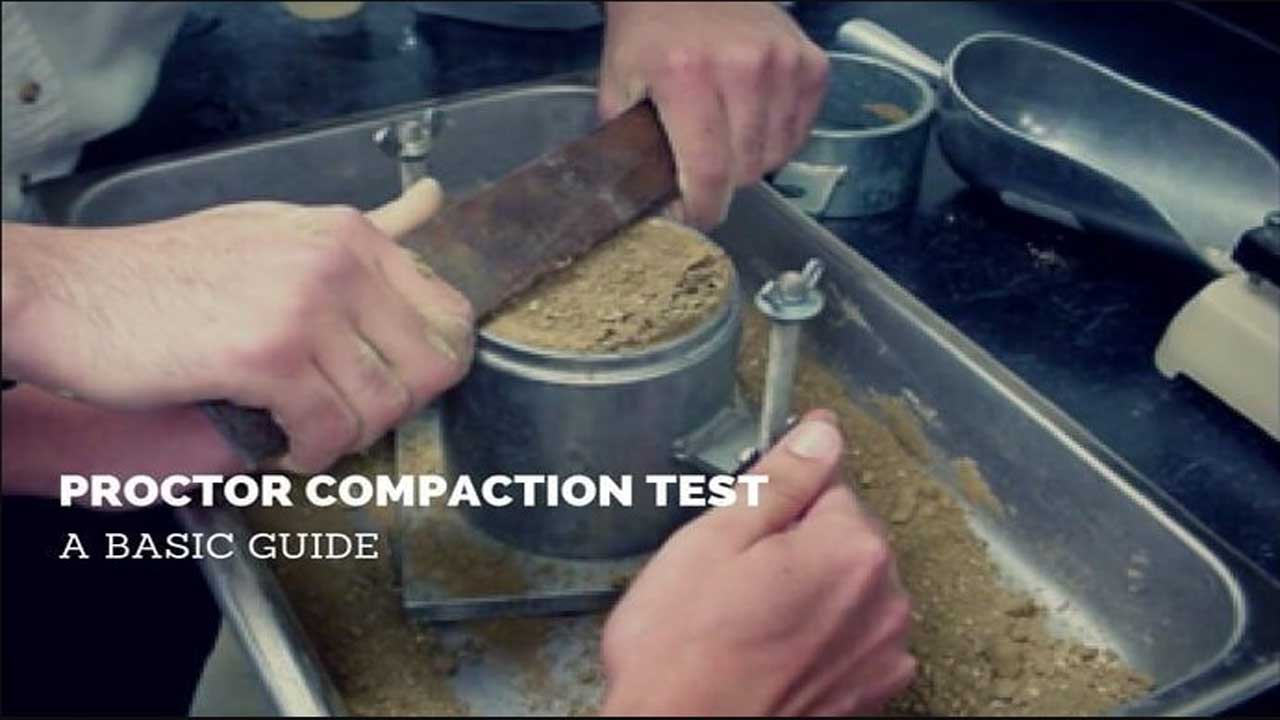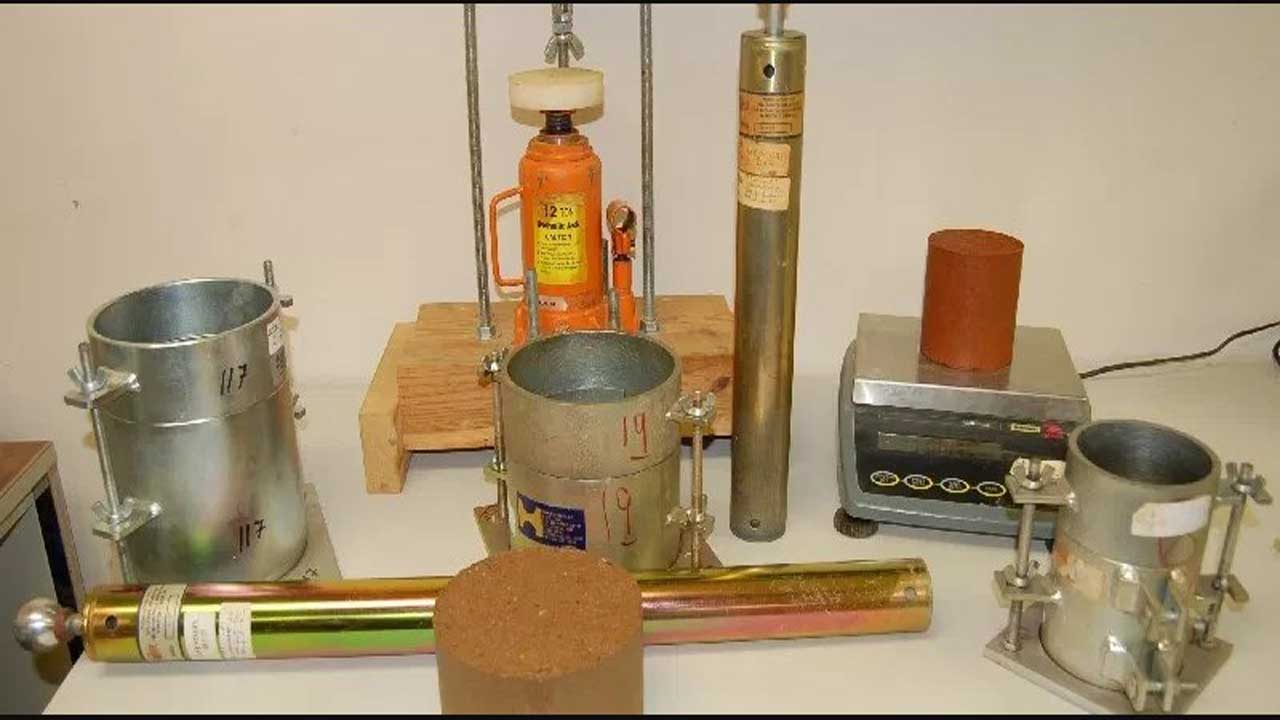Standard Proctor Compaction Test.
Standard Proctor Test is used to determine the compaction of different types of soil and the properties of soil with a change in moisture content.
So Let’s move on.
Standard Proctor Test Theory:
Compaction is a type of mechanical stabilization where the soil mass is densified with the application of mechanical energy also known as compactive effort.
The mechanical energy may be produced by the dynamic load, static load, vibration, or by tamping.
During compaction, the soil particles are relocated, and the air volume is reduced.
It may also involve a modification of the moisture content, and in the saturated coarse-grained soil, moisture content may be pressed out during the process of compaction.
Compaction should not be confused with consolidation;
where the density of saturated soils is increased due to a reduction in the volume of voids brought about by the expulsion of water under the application of static load.
Fundamentals of Compaction:
The fundamentals of compaction were first time presented by RR. Proctor in 1933, in his honor;
the standard laboratory compaction test which is developed is commonly called the Standard Proctor Test.
According to Proctor, the compaction of a soil mass is dependent on the following four major factors:
1. Soil type,
2. Moisture Content,
3. Compactive effort,
4. Dry density of the soil.
Soil type and Moisture content.
For a given type of soil and compactive effort, the dry density of a soil mass varies with moisture content.
At low moisture content, the internal friction and adhesion between the particles contribute to the resistance to compaction.
As the moisture content increases the particles develop moisture films around them, which help in lubricating the particles, thus increase the workability of the soil mass.
It does not increase any further when the moisture content is increased beyond a certain particular value of the moisture content;
as the water at this stage starts replacing the soil particles and as the unit weight of water is less than that of soil particles the density starts decreasing.
The particular value of moisture content at which maximum dry density of a soil mass is attained for a given compactive effort and is known as the optimum moisture content (OMC).
Compaction Effort.
Both the magnitude of compacting energy and the type of compactive effort influence to a greater extent the compaction of soils.
Cohesion less soils are efficiently compacted by Vibrations in the field hand operated vibrating plates, and motorized vibratory rollers of various sizes are used for compaction of sand, gravel, etc.
Rubber-tired roller (pneumatic roller) can also be used for this purpose.
Even large free falling weights have been used to dynamically compact loose granular fills.
Fine-grained soils may be compacted in the laboratory by falling weights and hammers (rammers) by special kneading compactors, and even under static pressure applied by compression machine.
In the field, sheep foot rollers, rubber-tired rollers and other type of heavy compaction equipment including hand tamper may be used.
Standard:
1. AASHTO: T99-86,
2. ASTM: D698-91,
3. BS1377: Part 4; Clause 3.
2. Standard Proctor Test Apparatus:
1. Cylindrical Metal Mold, having internal diameter 4” (10.16 cm) or 6” (15.24 cm), the internal effective height of 4.6” (11.7 cm);
and the mold should have detachable base plate & collar of 2 inches (5.08 cm).
2. Rammer, weighing 5.5 lbs (2.5 kg) & having fall of 12 inches (30.5 cm), with a flat circular face of 2” diameter.
3. Sensitive Balance, sensitivity ranging from 0.1 gram to 1 gram.
4. Thermostatically controlled oven (105°C +- 110°C)
5. Steel straight edge.
6. Moisture containers.
7. Sieve No.4.
8. Tray & scoop.
9. Graduated cylinder.
10. Mixing tools. (spoon, trowel, spatula).
1. Take sufficient quantity of representative soil, air dry & pulverize it with a rubber mallet. Sieve the soil through No: 4 sieve & reject the coarser material. 2. Take about, 3 kg of soil, add water to bring its water content to about 5% below the estimated optimum moisture content. (for coarse-grained soil 4% initial water content & for fine-grained soil 10% initial water content is preferable). Then Mix it thoroughly. 3. Clean the mold, measure its diameter & height & weigh it without the collar. 4. Fit the collar & compact the moist soil in three equal layers by the rammer with evenly distributed blows to each layer. Use 25 blows for 4 inches diameter & 56 blows for 6 inches diameter mold to the total height of mold with collar. 5. Remove the collar trim the compacted soil even with the top of the mold with a straight steel edge. 6. Remove the soil from the mold, split it & take about 100 grams sample for water content determination. 7. Break the soil lamps, mix it with remaining soil in the tray. Add more water to increase the water content by 2 to 3% & repeat the compaction procedure for each increment of water until the mass of the compacted soil decreases. 8. Calculate Water content for each trail & corresponding dry density. 9. Plot the compaction curve between water-content as abscissa & dry density as ordinate. 10. Note the water content against the peak of the curve as optimum moisture content & the corresponding dry density as maximum dry density. The wet Density or Bulk Density of soil is computed as: r = weight of compacted soil/volume of mold. After determination of moisture content of the soil, the Dry Density of Soil is computed as: rd = r / 1+m. Note: 1. wt. = weight. 2. cont: = container Note: 1. wt. = weight. 2. cont: = container. 3. gm =grams. 4. cc = cm3 The Maximum Dry Density of the Soil = _____________. The Optimum Moisture Content (OMC) = _______________. Q.1: What is meant by Compaction of Soil? Q.2: Who presented this Soil Compaction Test and when it was presented? Q.3: The term OMC stands for? Q.4: Define Optimum Moisture Content (OMC) of Soil. Q.5: What was the Weight & Fall of the rammer used in this Soil Compaction Test? Read More: Consolidation Test of Soil; Its Scope, Apparatus, Procedure.3. Standard Proctor Test Procedure:
Clean outside of the mold & base plate & weigh it.4. Observation and Calculations.
Moisture Content Determination.
Sample #
Moisture Can No.
Wt. of Cont: + Wet Soil.
Wt. of Cont: + Dry Soil.
Wt. of Water.
Wt. of Empty Container.
Density Determination.
Moisture Content. (%)
Wt. of Soil + Mold. (gm)
Wt. of Mold. (gm)
Wt. of soil in Mold. (gm)
Wet Density, r. (gm/cc)
Dry Density, rd (gm/cc)
5.The Result of Soil Compaction Test.
6. Q & A about Standard Proctor Test.
Ans: Re-arranging of soil mass by mechanical means is knows as Compaction of Soil.
Ans: This Soil Compaction Test was presented by R.R Proctor in 1933.
Ans: OMC stands for Optimum Moisture Content.
Ans: The Maximum Moisture Content at which the Maximum Dry Density of a sol mass is attained.
Ans: Weight of the rammer was 5.51 lbs and fall of the rammer was 12 inches (30.5 cm).




Hello There. I found your blog using msn. This is a really well written article.
I’ll make sure to bookmark it and come back to read more
of your useful information. Thanks for the post.
I will definitely return.
Excelant!
information is not sufficient, density curve not shown,conclusions and comments are not included.
We urgently need to oder this instrument
We urgently need to order this instrument
it so very good explanations
thanks
This theory is exceptionally amazing and helpful. Keep it Up. Thanks a lot